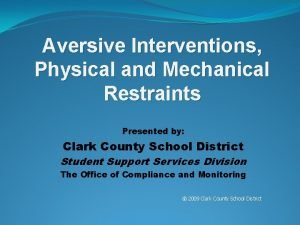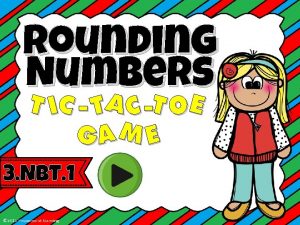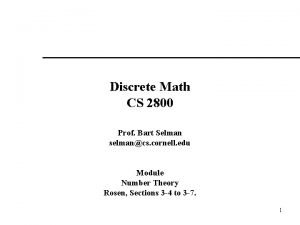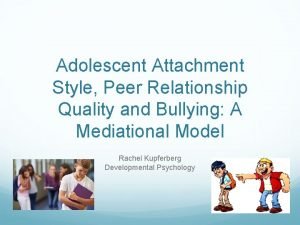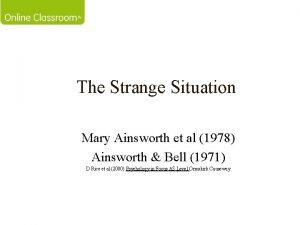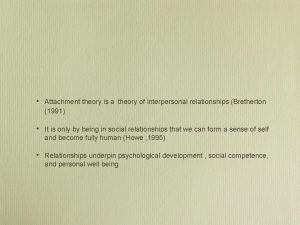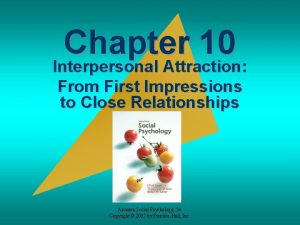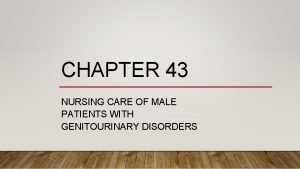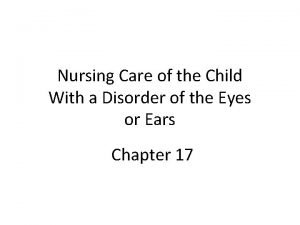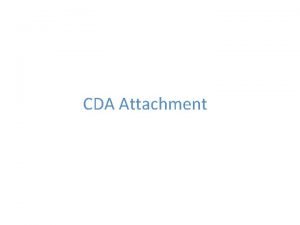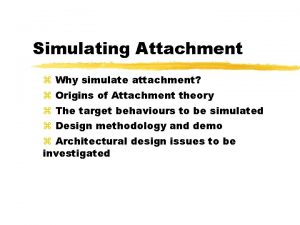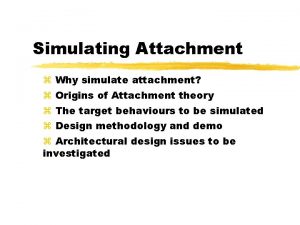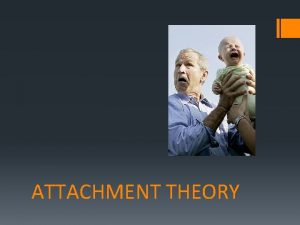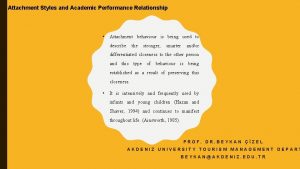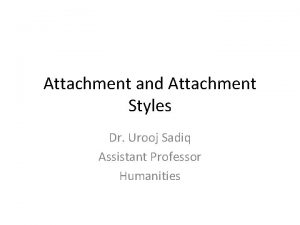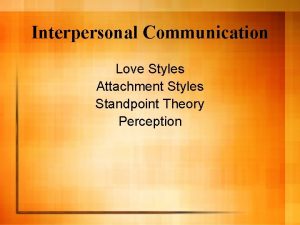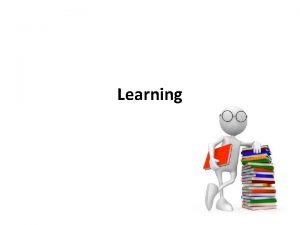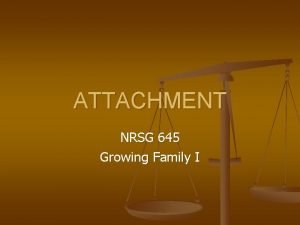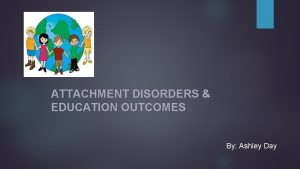Attachment Disorders NURSING 624 645 Attachment Styles l



















- Slides: 19

Attachment Disorders NURSING 624 & 645

Attachment Styles l Secure l Ambivalent l Avoidant l Disorganized

Secure Attachment l As Children As Adults Able to separate from parent Have trusting, lasting relationships Seek comfort from parents when frightened Tend to have good self-esteem Return of parents is met with positive emotions Comfortable sharing feelings with friends and partners Prefers parents to strangers Seek out social support

Ambivalent Attachment As Children: As Adults: May be wary of strangers Reluctant to become close to others Become greatly distressed when parent leaves Worry that their partner does not love them Do not appear to be comforted by return of parent Very distraught when a relationship ends

Avoidant Attachment As Children As Adults May avoid parents May have problems with intimacy Does not seek much comfort or contact from parents Invest little emotion in social and romantic relationships Shows little or no preference between parent and stranger Unable or unwilling to share thoughts and feelings with others

Disorganized Attachment Definition: Children show a lack of clear attachment behavior At Age 1 At Age 6 Show a mixture of avoidant and resistant behaviors May take on a parental role May seem dazed, confused, or apprehensive Some children act as a caregiver toward the parent

Attachment Issues l Adverse childhood experiences have profound effects on later development, physical health, psychological development, and a variety of other domains (Edwards, Holden, Felitti, Anda (2003). l Providing for effective treatment of such children is a public health concern (Walker, Goodwin, & Warren, 1992; Felitti, 2002)

Maltreatment in Children and Results l Children with early chronic histories of maltreatment may develop impairments related to: l l l l Attachment Biology Emotional Regulation Dissociation Behavioral Regulation Cognition Self-Concept

Assessment of Child Impairment l Large body of literature describing effects of early maltreatment on later child development, behavior, and functioning l Children reared in orphanages show significant cognitive delay of 8 IQ points when compared with similar children placed in foster care or raised with biological parents l Negative sequelae of early institutionalization l (Nelson, Zeanah, Fox, Marshall, Smyke, & Guthrie, 2007)

Assessment (continued) l Children with physical/psyc neglect, physical abuse, sexual abuse at risk of developing severe psychiatric problems l Likely to develop reactive attachment disorder (Lyons. Ruth & Jacobvitz, 1999)and may be described as experiencing Complex Trauma l When this trauma is caused by primary caregiver, the normal development of secure attachment is disrupted. Such children are at risk of developing a disorganized attachment

Assessment (continued) l Disorganized attachment is associated with developmental problems including depression anxiety, and acting out symptoms (Lyons-Ruth, 1996, Alpern & Pepacholi, 1993). l These children are also at significant risk for a variety of other behavioral, neuropsychological, cognitive, emotional, interpersonal, and psychobiological disorders (Cook, et al. , 2005; van der Kolk, 2005). l Many are violent & aggressive

Assessment (continued) l As adults they are at risk of developing a variety of psychological problems and personality disorders including: ¡Antisocial personality disorder ¡Narcissistic personality disorder ¡Borderline personality disorder ¡Psychopathic personality disorder

Assessment (continued) l Neglected children are at increased risk of social withdrawal and rejection, and have pervasive feelings of incompetence (Finzi et al. , 2000) l Children with histories of abuse and neglect are at significantly higher risk of developing Post Traumatic Stress Disorder as adults (Allan, 2001; Andrews, Varewin, Rose, & Kirs, 2000).

Assessment (continued) l Sexually abused children are at significant risk of developing: l anxiety disorders (2 x the average) l Major depressive disorders (3. 4 x the average) l Alcohol abuse (2. 5 x the average) l Drug abuse (3. 8 x the average) l Antisocial behavior (4. 3 x the average) l (Mac. Millian, 2001).

Adult Attachment Disorder and Tx l Unresolved childhood attachment issues leave adults vulnerable to difficulties in forming secure adult relationships l Patterns of attachment continue through the life cycle and across generations l New relations are affected by expectations developed in past relationships l A strong correlation between insecure adult attachment and marital dissatisfaction and negative marital interactions

Assessment of Adult Attachment l Dependent upon genetic personality, early life events insecurely attach adults are avoidant or ambivalent/anxious l Avoidant ¡ ¡ ¡ ¡ ¡ Intense anger and loss Hostile Critical of others Sensitive to blame Lack of empathy View others as untrustworthy Views others as undependable Views self as unlovable or “too good” for others Relationships feel too threatening or not worth the effort Compulsive self-reliance Passive withdrawal Low levels of perceived support Difficulty getting along with co-workers, would rather work alone Fear of closeness in relationships Avoidance of intimacy Unlikely to idealize the love relationship Tendency toward introjective depression (self critical)

Adult Assessment § Anxious/Ambivalent Compulsive caregiving Feels overinvolved and underappreciated Rapid relationship breakups Idealizing of others and relationships Strong desire for partner to reciprocate in relationship Desire for extensive contact and declarations of affections Overinvests emotions in relationship Preoccupation with relationship Dependence on relationship Heavy reliance on partner Perceives others as difficult to understand Relationship is primary method by which one can experience a sense of security Sensitive to rejection Discomfort with anger Extreme emotions Jealous Possessive Views self as unlovable Suicide attempts Mood swings

Goals of Therapy l Identify early losses l Mourn loss of that which never was but yearned for deeply l Provide closure to unresolved relationship longings with parental attachment figures l Reorganize belief system and physiological reaction to attachment relationships

Change l Attachment styles are not fixed in stone Provision of: l Positive life experience l Appropriate therapeutic intervention l Strong desire for change ¡Adults can alter their relationships and experience true intimacy and closeness
 624 bc
624 bc талес из милета
талес из милета 550 en romanos
550 en romanos Ccf 624
Ccf 624 645 rounded to the nearest hundred
645 rounded to the nearest hundred Tt-p-645
Tt-p-645 Use algorithm 5 to find 11^644 mod 645
Use algorithm 5 to find 11^644 mod 645 Approximate 645 to the nearest hundred
Approximate 645 to the nearest hundred 645 transformations
645 transformations Consequence analysis dp
Consequence analysis dp 3^644 mod 645
3^644 mod 645 Attachment styles in relationships
Attachment styles in relationships Ainsworth et al., 1978
Ainsworth et al., 1978 Disorganized attachment
Disorganized attachment Attachment styles in relationships
Attachment styles in relationships Hirschsprung disease nursing management
Hirschsprung disease nursing management Nursing diagnosis for undescended testis
Nursing diagnosis for undescended testis Nursing diagnosis for pud
Nursing diagnosis for pud Nanda nursing diagnosis for eye disorders
Nanda nursing diagnosis for eye disorders Nursing management of sleep disorders
Nursing management of sleep disorders



